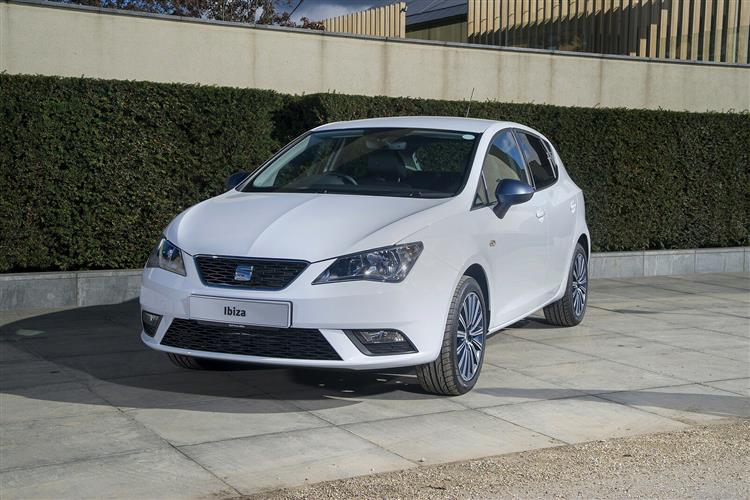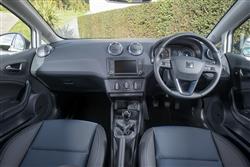How will you view?
This is a sample, showing 30 seconds of each section.
SUPERIOR FROM IBERIA? (some text hidden) SECTIONED_new_seatibiza_2016
By Jonathan Crouch
Introductionword count: 54
SEAT launched the fourth generation version of its Ibiza supermini, but subsequently never stopped trying to improve it. The final set of revisions arrived in 2015 to carry this design through the final couple of years of its life. It's these 2015 to 2017-era models that we evaluate here as a used car buy.
Modelsword count: 18
3/5dr hatch. 5dr estate (1.0, 1.2, 1.4 petrol, 1.4 TDI diesel [E, S A/C, SE, FR, Cupra, Toca])
Historyword count: 224
The 'Sociedad Espanola de Automoviles de Turismo' - or 'SEAT' as we better know it - is well used to injecting a little life into the mainstream market. Its 600 model, launched in 1957, is the fun little runabout credited with putting Spain on wheels, over a million being sold to bronzed Iberians in just eleven years. Only when Volkswagen took control of the brand in 1986 though, did its appeal start to spread to the rest of Europe, with the Ibiza supermini the sales spearhead and this MK4 model, launched in 2008, generally acknowledged as the company's most competitive proposition yet. A few years on though and with toughening small car competition, it was clear that a bit of a re-think might be needed to keep this car current. We got a refresh in 2012, then a more far-reaching update announced in the Autumn of 2015 - the one we evaluate here. This later package of changes brought an all-new 1.0-litre EcoTSI petrol engine and revised, more compliant suspension. SEAT reckoned though, that what buyers would really notice were the extra personalisation options, the smarter interior and the additional media connectivity. It was all just enough to carry this MK4 design through the final couple of years of its life. An all-new MK5 model made its debut in the early Summer of 2017.
What You Getword count: 1351
Whichever Ibiza bodystyle you choose for this 2015 to 2017-era Ibiza - the three-door SC, the more conventional five-door hatch or the ST estate - it won't at first glance appear to have changed very much over earlier versions of this MK4 model. But then few changes were needed. Short overhangs, subtle body creases and smart, angular headlamps still make this one of the smarter superminis in the segment from this period. The original distinctive 'arrowhead' shape was penned by stylist Luc Donckerwolke (the same guy who did the Lamborghini Gallardo supercar) and by 2015, it had matured nicely, changes being limited to subtle differences. If you've owned an original fourth generation Ibiza model before, seeing this post-2015-era version will be a bit like meeting an old friend who's had the odd nip and tuck on the sly. In terms of being more specific, well you really do have to know what to look for. Apart from a more stylish range of alloy wheels, the only really obvious exterior change with this updated post-2015-era model lies with the addition of LED daytime running light strips within the headlight clusters - and you only get them if you avoid the least expensive trim levels. Otherwise, SEAT felt that there wasn't much point in further changing the front end, given that it had been previously updated in 2012 with a narrower, sharper trapezoidal grille that aimed to add a bit of visual width and purpose to the overall shape. This sits above a sharply-contoured bumper with angular creases intended to naturally draw the eye down the car's flanks. At the rear, the key post-2015-era change related to lighting. Where LED technology features at the front, the rear clusters also feature it, creating a more distinctive night time signature. Otherwise, the look is as smart and clean as it was in previous MK4 Ibiza models, especially with the sportier-looking bumper and more potent-looking twin tailpipes that you get with the FR versions. View any Ibiza in profile and the main thing you'll notice will be something you'll probably either like or hate - the curious side slashes. One starts at the front wing, then falls to the middle of the rear door, while the other begins just ahead of the front door handle, then flows back towards the rear light cluster. It's a styling theme that looks great with the SC three-door bodyshape, but is more of an acquired taste when translated to five-door variants. Another design feature these more practical Ibiza models borrowed from the coupe SC version is the relatively low rakish roofline. You've got 22mm less roof height here than you'd have with, say, a Skoda Fabia and that makes all the difference when it comes to visually distancing this SEAT from some of its boxily boring rivals. You'd think that rear seat folk might have to pay for that and for sure, with the three-door 'SC' bodystyle, there's something of an issue with restricted rear headroom. You won't be struggling quite as much in that regard if you go for a five-door bodystyle but the reality is that you will still be getting a bit less headroom than is usual for cars from this class. Fortunately for SEAT, typical Ibiza buyers are people with young families, so that never proved to be much of a sales impediment: up to three kids will be quite comfortable back here. For us, slightly more of an issue is the rather over-high central transmission tunnel you'd think you wouldn't need on a front wheel drive supermini. It's one of the things that'll make it very difficult indeed to transport three adults for any distance in this car, though if you do have to do that, it will at least help that kneeroom is reasonable by class standards thanks to the recessed seatbacks. Taking a seat up-front brings you to the part of this car into which most of the design budget was poured when it came to this post-2015-era facelifted model's package of changes. That was a wise choice on SEAT's part. There was never very much wrong with the way that the outside of this Ibiza looked, but earlier versions always felt dull, cheap and plasticky once you got behind the wheel. This one was much nicer thanks to many elements borrowed from its larger Leon family hatchback stablemate, including a smarter dash and upgraded upholstery. One of the most visible changes is the redesigned instrument cluster you view through the smart three-spoke multi-function steering wheel. Get comfortable in front of it - easy thanks to reach and rake-adjustment and a height-adjustable seat - and you view two clear dials with sporty-looking white numbering. The main gauges are separated by a black and white digital information display that duplicates the carousel-style graphics and much of the functionality of the infotainment screen that dominates the centre of the dash. In its standard 5-inch form, this display was offered in either black and white or colour guise, depending on the trim level chosen. As standard or as an option, plusher Ibiza derivatives got a larger 6.5-inch colour 'Media System Plus' screen, which included a Navigation system with voice control and came with a proximity sensor so that it could sense your finger coming towards it. Whatever screen set-up original owners favoured, SEAT reckoned they'd want to use the display to duplicate the functionality of smartphone handsets and view selected apps. That's possible if you get a variant equipped with what the brand called its 'Full Link' set-up, there to work through the 'MirrorLink', 'Android Auto' and 'Apple CarPlay' systems. Android users have the added advantage of being able to download two useful apps - the 'SEAT ConnectApp' for stationary use and the 'SEAT DriveApp' for when you're on the move. With these, you can do things like display personalised information from your Facebook account, get text-to-speak messaging that'll read out current Twitter or Facebook posts, view weather forecasts and even activate functionality through a range of individual gestures. So the Ibiza at-the-wheel experience is more media-savvy in the case of this post-2015-era model. Moving to practicalities, well there's most of what you'd expect. The door pockets are pretty small, but you get a decently-sized 10.7-litre glovebox, while further small compartments are provided lower down the fascia by your right knee and to the right of the pedal box. A small storage area at the bottom of the centre stack gives you USB, aux-in and 12v socket attachments and this sits ahead of two cupholders, with a third provided behind the (thankfully conventional) handbrake. As for luggage space, well press in the large SEAT logo that doubles as a boot release and the rear hatch of the five-door variant opens to reveal 292-litres of cargo room, marginally more than the 284-litre total offered by the sportier three-door SC bodystyle. True, that's nothing like as much capacity as you'd find in boxier superminis from this segment like Skoda's Fabia or Hyundai's i20, but it's pretty comparable to what you'd get from direct rivals like Ford Fiesta, Vauxhall Corsa and Peugeot 208 models from this era. If you do want more space, going for an Ibiza in ST estate guise will increase your boot capacity to 430-litres. As for practicalities in the boot area, well there's a bag hook - but no useful 12v socket or tie-down points to keep awkward items in place. You do get extra underfloor storage, but only if the model in question doesn't have a space-saver spare wheel. If you need more room, then of course you can as usual push forward the rear bench. It'll be split-folding provided you've avoided entry-level trim but it doesn't fall quite flat. Once retracted, up to 847-litres of space is revealed for both the three and five-door hatch bodystyles - or up to 1,164-litres if you've gone or the ST estate. That latter figure is 231-litres less than you'd get from a comparable but more boxy Skoda Fabia estate, but it's still enough to allow an owner to carry two bicycles with the front wheels removed.
To see the full road test text contact us on 0330 0020 227
Pictures (high res disabled)

.jpg)
|
.jpg)
|
.jpg)
| |||
.jpg)
|
.jpg)
|
.jpg)
| |||
.jpg)
|
.jpg)
|
.jpg)
| |||
.jpg)
|
.jpg)
|

|
Scoring (subset of scores)
Category: Small Runabouts
| Performance | |
| Handling | |
| Comfort | |
| Space | |
| Styling, Build, Value, Equipment, Depreciation, Handling, Insurance and Total scores are available with our full data feed. | |



